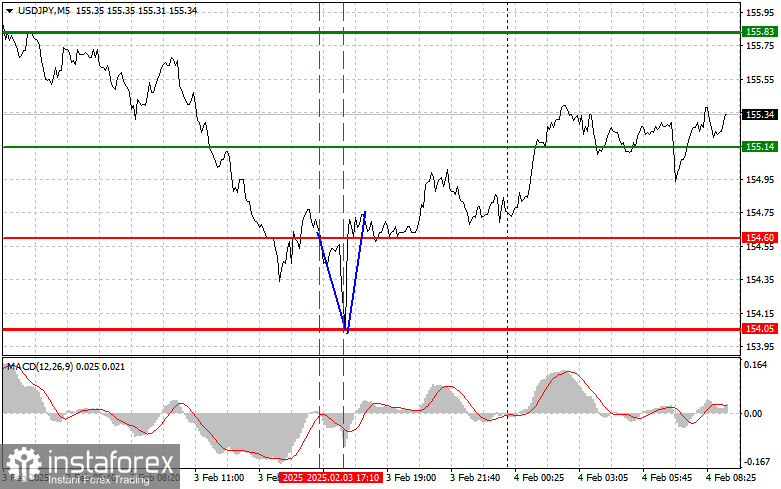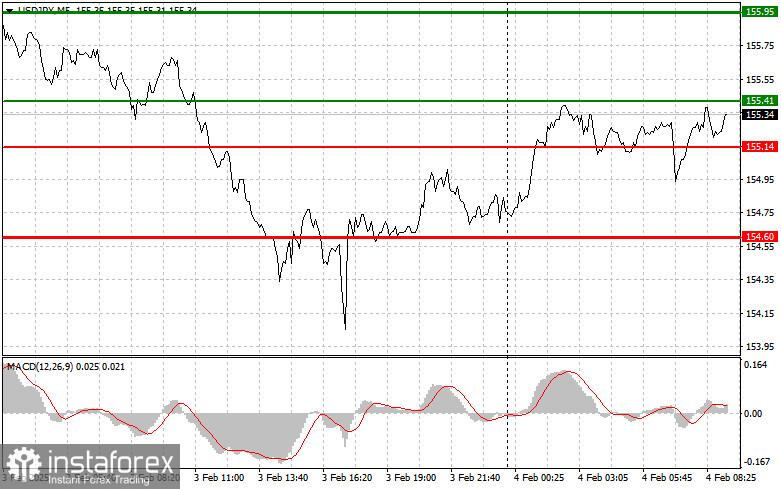Analysis of Trades and Trading Tips for the Japanese Yen
Testing the 154.60 level coincided with the MACD indicator starting to move downward from the zero mark, confirming an opportune entry point for selling the dollar. This resulted in the currency pair dropping by more than 50 pips. Additionally, buying on the rebound from 154.05 yielded a profit of around 40 pips.
The introduction of trade tariffs against Canada and Mexico ended as abruptly as it began, leading to a sell-off of the US dollar in the second half of the previous day. However, today's disappointing data regarding the reduction of Japan's monetary base placed renewed pressure on the yen. Although Japan is not currently facing significant economic growth issues, this reduction slightly worsened the situation and contributed to the strengthening of other currencies.
In terms of today's reports, little is expected to significantly impact the market. It is likely that trading will continue within the channel, with the possibility of sharp fluctuations occurring unexpectedly. As traders grow more confident in their expectations of further interest rate hikes, the likelihood of continued declines in the USD/JPY pair increases.
As for the intraday strategy, I will rely more on the implementation of Scenarios #1 and #2.

Buy Signal
Scenario #1: I plan to buy USD/JPY today if the entry point reaches around 155.41 (green line on the chart), with a target of rising to 155.95 (thicker green line). Around 155.95, I plan to exit long positions and open short positions in the opposite direction (expecting a 30-35 pip move from the entry point). It is best to return to buying the pair during corrections and significant USD/JPY pullbacks. Important! Before buying, ensure the MACD indicator is above the zero line and starting to rise.
Scenario #2: I also plan to buy USD/JPY today if there are two consecutive tests of the 155.14 price level while the MACD indicator is in the oversold zone. This will limit the pair's downward potential and lead to an upward market reversal. Growth towards the opposite levels of 155.41 and 155.95 can be expected.
Sell Signal
Scenario #1: I plan to sell USD/JPY today only after breaking below the 155.14 level (red line on the chart), which will lead to a rapid decline in the pair. The key target for sellers will be the 154.60 level, where I plan to exit short positions and immediately open long positions in the opposite direction (expecting a 20-25 pip rebound from the level). Pressure on the pair is unlikely to return today. Important! Before selling, make sure the MACD indicator is below the zero line and starting to decline from it.
Scenario #2: I also plan to sell USD/JPY today if there are two consecutive tests of the 155.41 price level while the MACD indicator is in the overbought zone. This will limit the pair's upward potential and lead to a market reversal downward. A decline towards the opposite levels of 155.14 and 154.60 can be expected.

Chart Notes
- Thin green line: Entry price for buying the trading instrument.
- Thick green line: A suggested target for Take Profit or manually locking in profits, as further growth above this level is unlikely.
- Thin red line: Entry price for selling the trading instrument.
- Thick red line: A suggested target for Take Profit or manually locking in profits, as further decline below this level is unlikely.
- MACD Indicator: Critical for identifying overbought and oversold zones to guide market entry decisions.
Important Note for Beginner Traders
- Always approach market entry decisions cautiously.
- Avoid trading during major news releases to sidestep volatile price swings.
- If trading during news releases, always set stop-loss orders to minimize losses.
- Trading without stop-loss orders or money management practices can quickly deplete your deposit, especially when using large volumes.
- A clear trading plan, like the one outlined above, is essential for successful trading. Spontaneous trading decisions based on current market conditions are inherently disadvantageous for intraday traders.





















